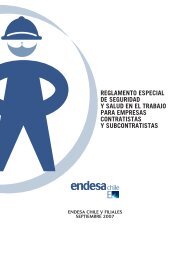Introducción al Cálculo de Caudales Ecológicos - Endesa..
Introducción al Cálculo de Caudales Ecológicos - Endesa..
Introducción al Cálculo de Caudales Ecológicos - Endesa..
Create successful ePaper yourself
Turn your PDF publications into a flip-book with our unique Google optimized e-Paper software.
INTRODUCCIÓN AL CÁLCULO DE CAUDALES ECOLÓGICOS / Un análisis <strong>de</strong> las ten<strong>de</strong>ncias actu<strong>al</strong>es<br />
Alternative<br />
Policy Element: Maximum Cumulative Diversion<br />
Region<strong>al</strong>ly Protective? Basis<br />
MCD1 (Rate): MCD Rate = 15% of 20% Yes Gener<strong>al</strong>ly <strong>al</strong>lows the lowest<br />
Winter (12/15-3/31) Exceedance Flow<br />
instantaneous rate of diversion. Likely<br />
results in negligible channel change<br />
over the long term.<br />
MCD2 (Rate): MCD Rate = 5% of 1.5 yr Yes Allows a higher instantaneous rate of<br />
flood peak flow (annu<strong>al</strong>ized series)<br />
cumulative diversion than MCD1 and<br />
MCD4. This <strong>al</strong>ternative will likely result<br />
in long term adjustment and reduction<br />
in channel size, but the potenti<strong>al</strong><br />
change is thought to be minor in terms<br />
of bankfull width, <strong>de</strong>pth, and surface<br />
grain size distribution. Basing a MCD<br />
rate on the 1.5 year flood peak flow<br />
rate more directly accounts for the<br />
relation between channel size and<br />
instream flow need.<br />
MCD3 (Volume): MCD Volume = Parti<strong>al</strong>ly May not be protective of coho and<br />
No restriction on diversion rate,<br />
Chinook upstream passage and<br />
stop diversion after the ratio of<br />
spawning habitat flow needs during<br />
tot<strong>al</strong> cumulative diverted volume to<br />
the first month of the diversion<br />
unimpaired runoff volume = 10%<br />
season (for DS1 or DS3) in dry and<br />
average years. May not be protective<br />
of channel maintenance flow needs.<br />
Protectiveness is related more<br />
<strong>de</strong>fensibly to flow rate rather than<br />
volume.<br />
MCD4 (Rate): MCD Rate = Diversion Yes, but impractic<strong>al</strong> to apply Provi<strong>de</strong>s a comparable level of<br />
rate that corresponds to a h<strong>al</strong>f-day<br />
instantaneous diversion rate to MCD1<br />
reduction in the duration of time that<br />
(15% of 20% winter exceedance flow).<br />
flow is above the MBF during a 1.5<br />
Likely results in negligible channel<br />
year flood event<br />
change over the long term. Impractic<strong>al</strong><br />
because its implementation<br />
requires <strong>de</strong>tailed hourly hydrograph<br />
information for each stream.<br />
Biologic<strong>al</strong> Recommendation: Apply Alternative MCD2. There is uncertainty in <strong>de</strong>fining the maximum<br />
amount of change in channel maintenance flows that could occur that would<br />
still be protective of anadromous s<strong>al</strong>monid habitat. Regardless of which MCD<br />
<strong>al</strong>ternative is chosen for the Policy, effectiveness monitoring data collected<br />
over a period of 10 to 20 years would be nee<strong>de</strong>d to assess whether the Policy<br />
could be reopened in the future to inclu<strong>de</strong> a less restrictive MCD that would<br />
still be protective of channel maintenance flows while offering the opportunity<br />
for higher diversion rates.<br />
Tabla B5<br />
Criterio <strong>de</strong>l Estado <strong>de</strong> C<strong>al</strong>ifornia para reglamentar la cantidad <strong>de</strong> agua que pue<strong>de</strong> ser extraída <strong>de</strong> un cauce.<br />
Fuente: State Water Resources Control Board, C<strong>al</strong>ifornia.<br />
47



